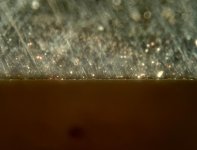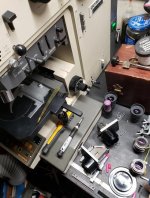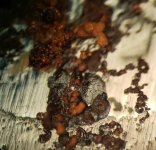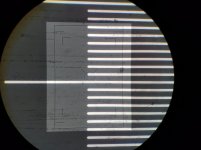The wave plates are used for measuring the change of index of refraction along crystal planes in minerals and ceramics with transmitted light. The mineral specimens are ground in thin sections to allow transmitted light imaging. The image of a single crystal is viewed using conoscopic observation with the built in Bertrand lens of your microscope . The crystal is centered in the field of view using your rotating stage. The objective turret will also have adjustments for centering the optical axis with respect to the crystal and eyepiece cross hairs.
Polarizing Petrographic Microscopes
The old Zeiss polarizing microscope was equipped with a fixed 1/4 lambda , fixed 1 lambda, variable 0 to 3 lambda, variable 0 to 5 lambda, variable 0 to 20 lambda, and a variable 1/10 lambda wave plate. The measured birefringence is used to identify crystal chemical composition using a catalog of mineral optical properties.
There is also a 1/4 lambda plate that is used for a de Senarmont compensator for quantitative DIC work. This wave plate has its optical axis aligned parallel with the polarizer axis. It is used with a rotating analyzer to measure light phase differences of up to 1 lambda. (Lambda = 5500 Angstroms)
The 1/4 lambda plate used for birefringence studies is rotated 45 degrees with respect to the polarizer axis.
The 1 lambda wave plate is also used to add color contrast to a transmitted light DIC image that would otherwise have no color. This is useful when examining unstained biological specimens.


















